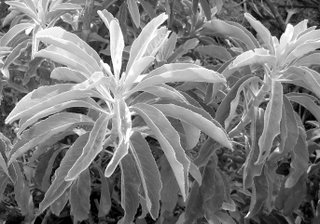April 2006 Los Feliz Ledger Column, "Swooning for the Moon"

Dudleya brittonii (Britton's live-forever/dudleya) at Santa Barbara Botanic Garden, photo by Carmen Wolf

Salvia apiana (white sage) at Griffith Park, photo by Carmen Wolf
As the weather begins to warm and signs of spring surreptitiously sprout, the time is ripe to make plans for future chilling under the stars alongside a garden designed to complement outdoor evenings.
Start by pulling together a collection of silver, gray and white leaved and flowering plants. They will glisten in the lunar glow and wow both you and your guests as you gather around an open fire pit or crackling chiminea and sip wine until all hours.
Some of the best botanical candidates for a moonlight garden are, of course, California natives. A vast number of them seem to have been designed just for this purpose. There simply isn’t enough space here to list all appropriate species, so I’ve selected a heavenly eleven. Each one needs full sun or part shade in the hottest areas, excellent drainage and occasional deep waterings in the summer. All are perennial and attractive to winged pollinators, making their presence enjoyable and beneficial. Plant them in the ground with the tallest in the back working your way down to the shortest in the front. Or, plop them in colorful pots on a patio, in which case they’ll need water about once a week or more, depending on the heat.
Salvia apiana (white sage) - an icon of California natives - is prized for intensely fragrant 3-4” long and 2” wide gray-green leaves that have been used in Native American traditions for years. Foliage and pale purple tinged white flowers beautifully reflect the light of the moon and stars. It eventually matures at about 3-5’ high and wide.
Several other sages satisfy the requirements of a moonlight garden. Try these two in particular: Salvia ‘Vicki Romo’ is a compact hybrid of S. apiana and S. clevelandii that grows to about 4’ high and 5’ wide and has lavender blue flowers and gray green leaves that are narrower and shorter than apiana.
Salvia ‘Allen Chickering,’ a hybrid of S. clevelandii and S. leucophylla (also a good candidate for moonlight gardens) grows to around 4’ high and wide, produces pale purple whorled flowers stacked along 1’ tall stems that blow gently in the breeze.
During late summer and early fall, Zauschneria californica (California fuchsia) produces some of the most stunning tubular scarlet flowers that are irresistible to hummingbirds. Fine, feathery silver leaves sparkle day and night. An arching habit makes Zauschneria sublimely suitable for trailing down terrace walls or crawling over the edges of large pots. Songbirds eat seeds so allow spent flowers to stick around for a while. When seeds are gone, cut back scraggly stems.
Two species of California buckwheat have such shockingly silver white leaves that they can’t be left out of a moonlight garden. Eriogonum crocatum (saffron buckwheat) is low and compact, reaching 1.5’ high and 2’ wide. Woolly white stems support 1” roundish leaves and yellow flowers that appear in flat clusters atop dainty stems from early spring until late summer.
Eriogonum giganteum (St. Catherine’s lace) looks like it is covered in old-fashioned white lace curtains when in bloom – from late spring into late summer. Broad oval leaves are 1-2.5” long and the plant can grow anywhere from 3-8’ high and branching freely out to about 5’ wide or more.
Butterflies and bees abound when both buckwheat beauties are in bloom and birds appreciate the seeds left post flower show.
Eriophyllum nevinii (Catalina silverlace), which matures at around 4-5’ high and 3-4’ wide, is a mystical match for the moon with silvery white, finely divided fern-like leaves. Butterflies and bees utilize orange-yellow flowers that appear in the fall.
Leymus condensatus ‘Canyon Prince’ (blue giant wild rye) is a 3’ high and wide striking gray-blue grass with sword-like leaves that are magnificent in massed plantings or interspersed with other perennials.
The following two native succulents will stop visitors in their tracks and shine brightly under a starlit sky. Dudleya pulverulenta (chalk dudleya) and Dudleya brittonii (Britton’s live-forever or Britton’s dudleya) are both compact with chalky white, plump and pointy wide foliage and long stems of red flowers in springtime. These guys will grow right out of the side of a cliff.
Last but not least is the luminous Lupinus albifrons (evergreen lupine) with shimmering silver star-shaped foliage and tall spikes of purple white flowers in the spring. It can get quite large, ranging from about 4-7’ tall and 4-8’ wide, especially when in bloom.
Feel free to experiment with other radiant natives that you may find in your travels. I haven’t included any of the silver bark trees and many other species that lend themselves to a moonlight garden. The possibilities are endless. Let your imagination run wild and reap the rewards every night, all spring and summer long.

0 Comments:
Post a Comment
<< Home